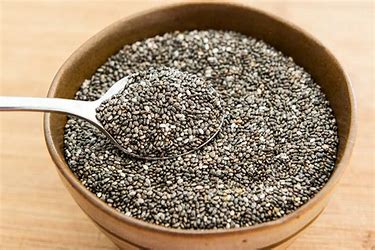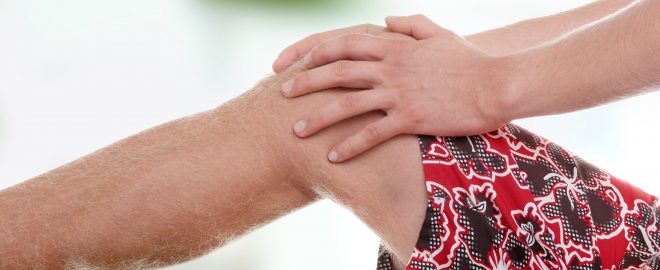
Keeping hearts beating.....
After all your support to raise money for the defibrillator it has finally arrived and we are waiting for installation now.
The added work to become more GDPR compliant has left reception with a lot of extra work - thank you everyone who has completed the forms so far - please remember to check your personal details VERY carefully and read the declaration as we need you to be fully aware of what you are allowing us to do with your data.
Don't forget to unsubscribe to this newsletter if you don't want to receive it any more.

Have you got your chia seeds in the cupboard yet?
Chia seeds (salvia hispanica) have become one of the most popular superfoods in the health community. They’re easy to digest when prepared properly and a very versatile ingredient that adds easily to recipes. Plus, chia seeds benefits are plentiful.
Originally grown in Mexico, the seeds were highly valued for their medicinal properties and nutritional value. In fact, they were even used as currency.
The chia seed is nutrient-dense and packs a punch of energy-boosting power. Aztec warriors ate chia seeds to give them high energy and endurance. They said just one spoonful of chia could sustain them for 24 hours. Chia means “strength” in the Mayan language, and chia seeds were known as “runners’ food” because runners and warriors would use them as fuel while running long distances or during battle.
Not only that, but recent research has found that the chia seeds benefits are even greater than we realized. Chia seeds benefits include promoting healthy skin, reducing signs of aging, supporting the heart and digestive system, building stronger bones and muscles, and more. They’ve even been linked to helping reverse diabetes. Continue reading for possible side effects, preparation instructions and a complete list of chia seeds benefits and nutrients.
read more:https://draxe.com/chia-seeds-benefits-side-effects/?utm_campaign=chiaseeds&utm_medium=social&utm_source=facebook&utm_content=draxe

Can You Be Too Supple?
Some people are very flexible, while others aim to improve their flexibility through yoga classes and stretching exercises. However, have you ever considered that there is such as thing as too supple?
Hypermobility means that you can move some or all of your joints in a way that most people cannot, without pain. Joint hypermobility is what some people refer to as having “loose joints” or being “double-jointed”. The joints most commonly affected are the knees, shoulders, elbows, wrists, and fingers.
Many people with hypermobility do not experience any problems. In fact, people such as dancers, gymnasts and musicians can actually benefit from the increased flexibility. However, there are times that you should seek medical advice and treatment for hypermobility.
People should seek treatment if they experience:
- Pain in the loose joint during or after movement
- Sudden changes in the appearance of the joint
- Changes in mobility, specifically in the joints
- Changes in the functioning of your arms and legs
Often additional symptoms are minimal and may only become apparent after minor trauma.
In addition to genetic factors, hypermobility can be caused by weak muscles supporting the joint.
Other causes of hypermobile joints can include trauma, developmental issues, and hormonal factors.
During pregnancy the female body increases production of the hormone oestrogen and produces the hormone relaxin. The function of these hormones is to increase ligament laxity enabling the female pelvis to accommodate the growing foetus and helps to open the birth canal during labour. It can also cause hypermobility of the lumbar spine and of the sacroiliac joints of the pelvis.
Treatment for hypermobility syndrome can include strengthening exercises that will stabilise the joint. It is also useful for people to develop an awareness of what the normal range of motion is for each joint in order to avoid hyperextension. However, those with related medical conditions or who are pregnant should seek the advice of their chiropractor to establish a safe exercise plan.

Fatigue – A Modern Epidemic?
Fatigue is one of two main ways the body warns you about a problem. The other warning is pain. Most of us pay attention to pain, and stop whatever is causing it. We don’t pay as much attention to fatigue. One reason might be that fatigue sneaks up on us.
What Is Fatigue?
Fatigue is tiredness that does not go away when you rest. It can be physical or psychological. With physical fatigue, your muscles cannot do things as easily as they normally do. You might notice this when you climb stairs or carry bags of groceries.
With psychological fatigue, it may be difficult to concentrate for as long as you did before. In severe cases, you might not feel like getting out of bed in the morning and doing your regular daily activities. Fatigue is twice as common in women as in men but is not strongly associated with age or occupation.
There are certain things that exacerbate fatigue, including a range of lifestyle, occupational and psychological factors.
Lifestyle-related factors
Common lifestyle choices that can cause fatigue include:
- Lack of sleep – adults need between 7 and 9 hours of sleep per night.
- Too much sleep – sleeping more than 11 hours per day can lead to excessive daytime sleepiness.
- Alcohol and drugs – alcohol is a depressant drug that slows the nervous system and disturbs normal sleep patterns. Other drugs, such as cigarettes, stimulate the nervous system and make insomnia more likely.
- Sleep disturbances – disturbed sleep may occur for a number of reasons, for example, young children who wake in the night, a snoring partner, or an uncomfortable bed.
- Lack of regular exercise and sedentary behaviour – physical activity is known to improve fitness, health and wellbeing, reduce stress, and boost energy levels. It also helps you sleep. Regular exercise is also an effective treatment for anxiety and depression, however any exercise regime should be supervised by a qualified health practitioner for those with depression or chronic fatigue syndrome.
- Too much exercise – Those who work hard and regularly exercise hard may be trying to do too much. Your body also needs time to recover.
- Poor diet – low calorie diets, or extreme diets that reduce intake of a particular macronutrient such as carbohydrates may mean that the body does not have enough fuel. Quick fix ‘pick me ups’, such as chocolate bars or caffeinated drinks, only offer a temporary energy boost that quickly wears off and worsens fatigue in the longer term.
Workplace-related factors
Common workplace issues that can cause fatigue include:
- Shift work – the human body is designed to sleep during the night. This pattern is set by a small part of the brain known as the circadian clock. A shift worker confuses their circadian clock by working when their body is programmed to be asleep.
- Workplace stress – can be caused by a wide range of factors including job dissatisfaction, heavy workload, conflicts with bosses or colleagues, bullying, constant change, or threats to job security.
Psychological factors
Studies suggest that at least 50 per cent of fatigue cases are caused by psychological factors. These may include:
- Depression – this illness is characterised by severe and prolonged feelings of sadness, dejection and hopelessness. People who are depressed commonly experience chronic tiredness.
- Anxiety and stress – a person who is chronically anxious or stressed keeps their body in overdrive. The constant flooding of adrenaline exhausts the body, and fatigue sets in.
- Grief – losing a loved one causes a wide range of emotions including shock, guilt, depression, despair and loneliness.
Always see a medical practitioner or GP to make sure that your fatigue isn’t caused by an underlying medical problem. Your chiropractor can often help by making sure that your muscles, joints and bones are all working together as they should; minor misalignments can cause your body to lock up trying to protect itself. Improving your diet, sleeping patterns and exercise regime will also provide real benefits in the long run.

Support for Women
Prevent back pain through a well-fitted bra…
Did you know that wearing an ill-fitting bra could lead to real back pain? Around half of women have said they’ve suffered from back pain at some point in their life and have claimed that their breast size was a contributing factor.
Making sure you wear a properly fitting bra could eliminate much of the pain. Remembering these key points next time you’re purchasing a bra might come in handy:
- You need a well-engineered bra so your shoulders don’t take all of the strain and end up doing all of the work; spreading the weight bearing is important.
- Bras that don’t fit will affect the shoulders and chest and may cause back pain as you get older; it is important to make sure a bra gives you as much support as possible.
- The key things to remember are: make sure you get properly fitted bra and replace old ones once they start to lose their supportive properties!
We treat all conditions that affect any muscle or joint in your body, from your head to your little toe! One of the most common complaints that we treat is back pain and Chiropractic is recommended by the government authority, the National Institute for Clinical Excellence (NICE) for acute and chronic back pain. Some of the other conditions that we treat are neck and headache, shoulder pain, leg and hip pain, knee and foot pain, sciatica and arthritis. Our registered Chiropractors all have at least five years of training. Treatment costs can be covered through most health insurers. If you are in any doubt, we are always very happy to talk with you on the phone to see if your condition will respond well to Chiropractic treatment. Call the clinic now to arrange an appointment time that works for you. 0115 9225085 If you would like to opt-out of receiving these newsletters please follow the unsubscribe link below, email alex@beestonchiropractic.co.uk or let us know at your next appointment.





